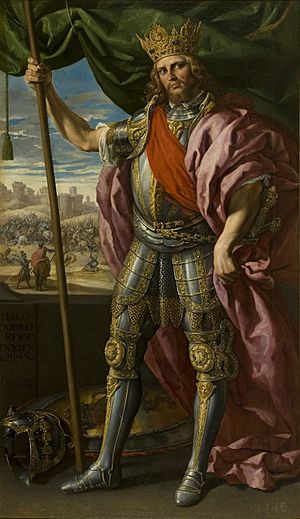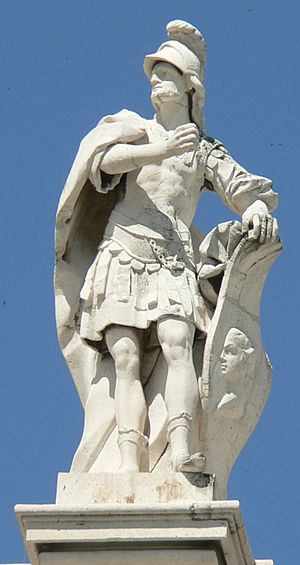Theodoric I facts for kids
Quick facts for kids Theodoric I |
|
|---|---|
| King of the Visigoths | |

Imagined portrayal of Theodoric, King of the Goths, by Félix Costello, 1635.
|
|
| Reign | 418–451 AD |
| Coronation | 418 AD |
| Predecessor | Wallia |
| Successor | Thorismund |
| Born | 390 Peuce Island, Dobruja |
| Died | 20 June 451 (aged 60–61) Battle of Chalons |
| Burial | Tomb of Theodoric, Poix, Marne, France |
| Issue | Thorismund Theodoric II Frederic Euric I Retimer Himnerith |
| Dynasty | Balt |
| Father | Alaric I |
| Religion | Arianism |
Theodoric I (born around 390 or 393 AD, died June 20 or 24, 451 AD) was a powerful king of the Visigoths. He ruled from 418 to 451. Theodoric is best known for his important role in stopping the famous leader Attila and his Huns. This happened at a huge battle called the Battle of the Catalaunian Plains in 451, where King Theodoric sadly lost his life.
Contents
Becoming King and Expanding Territory
Theodoric became king in 418 AD, taking over from King Wallia. The Romans had told King Wallia to move his people from Spain to Gaul (modern-day France).
As king, Theodoric helped the Visigoths settle in new areas of Gaul. He then used the fact that the Roman Empire was getting weaker to make his own kingdom bigger, especially towards the south.
After the Roman Emperor Honorius died in 423, there were fights for power within the Roman Empire. Theodoric saw this as a chance to capture Arelate, an important city for travel. However, a Roman general named Aëtius, who had help from the Huns, managed to protect the city.
The Visigoths and Romans then made a peace agreement. As part of this, some important Roman noblemen were sent to live with Theodoric as a sign of trust. One of these was Avitus, who later became an emperor. He lived at Theodoric's court and even taught his sons.
Reaching the Mediterranean Sea
In 435, the Romans were busy fighting against the Franks, who were attacking cities like Cologne and Trier. Theodoric saw another chance to expand his kingdom. He tried to capture Narbo Martius in 436. Taking this city would give him access to the Mediterranean Sea and important roads leading to the Pyrenees mountains.
However, a Roman commander named Litorius, also with help from the Huns, stopped Theodoric from taking the city. He pushed the Visigoths back to their capital city, Tolosa. Theodoric offered peace, but it was refused.
King Theodoric then won a major battle at Tolosa. Litorius was badly hurt and later died while being held by the Goths. Avitus, following orders from Aëtius, went to Tolosa and offered a peace treaty, which Theodoric accepted. It's possible that the Romans officially recognized the Visigoth kingdom as independent around this time.
Dealing with Other Kingdoms
Theodoric's daughter had married Huneric, the son of the Vandal ruler Genseric. But Huneric later wanted to marry Eudocia, the daughter of the Roman Emperor Valentinian III.
In 444, a former Roman general named Sebastianus, who was an enemy of Aëtius, came to Tolosa. This could have caused problems between Theodoric and Aëtius. But Theodoric quickly sent Sebastianus away. Sebastianus later captured Barcelona but was then killed by Genseric in 450.
Theodoric was also an enemy of the Suevic king Rechila in Spain. Visigoth soldiers helped a Roman commander fight against the Suevi in 446. But the Suevi were strong defenders, and the Vandals and Romans started getting along better. This made Theodoric change his plans.
In February 449, he married one of his daughters to the new Suevic king, Rechiar. Rechiar visited his father-in-law, Theodoric, in Tolosa in July 449. When Rechiar returned home, he attacked the area around Caesaraugusta and managed to take Ilerda with help from Visigoth troops.
Forming an Alliance Against the Huns
When Attila the Hun finally invaded Gaul, Avitus helped create an alliance. He brought together Theodoric and his old enemy, the Roman general Aëtius, to fight against the Huns. Theodoric joined this group because he knew the Huns were a big danger to his own kingdom.
Theodoric gathered his entire army and his sons, Thorismund and Theodoric, and joined forces with Aëtius. The Visigoth and Roman armies then saved the city of civitas Aurelianorum and forced Attila to retreat in June 451.
The Battle of Châlons
After saving Orléans, Aëtius and Theodoric followed the Huns. They fought them at the Battle of Châlons near Troyes in June 451. Most of the Visigoths fought on the right side of the battle under Theodoric's command. A smaller group fought on the left under his son, Thorismund.
Theodoric's forces played a very important part in the Roman victory. However, King Theodoric himself was killed during the battle. There are two stories about how he died: one says he was thrown from his horse and trampled; the other says he was killed by a spear from an Ostrogoth warrior named Andag.
Theodoric's body was found the next day. Following Visigoth traditions, his warriors mourned him and buried him right there on the battlefield. Immediately after his death, his son Thorismund was chosen to be the new king. Theodoric had other sons, including Theodoric II, Frederic, Euric I, Retimer, and Himnerith.
Theodoric's Lasting Impact
Because of his bravery and the victory over Attila at the Battle of the Catalaunian Plains, Theodoric became a very respected figure in Western history. He even inspired the author J. R. R. Tolkien when he created the character King Théoden of Rohan in The Lord of the Rings.
See also
 In Spanish: Teodorico I para niños
In Spanish: Teodorico I para niños


